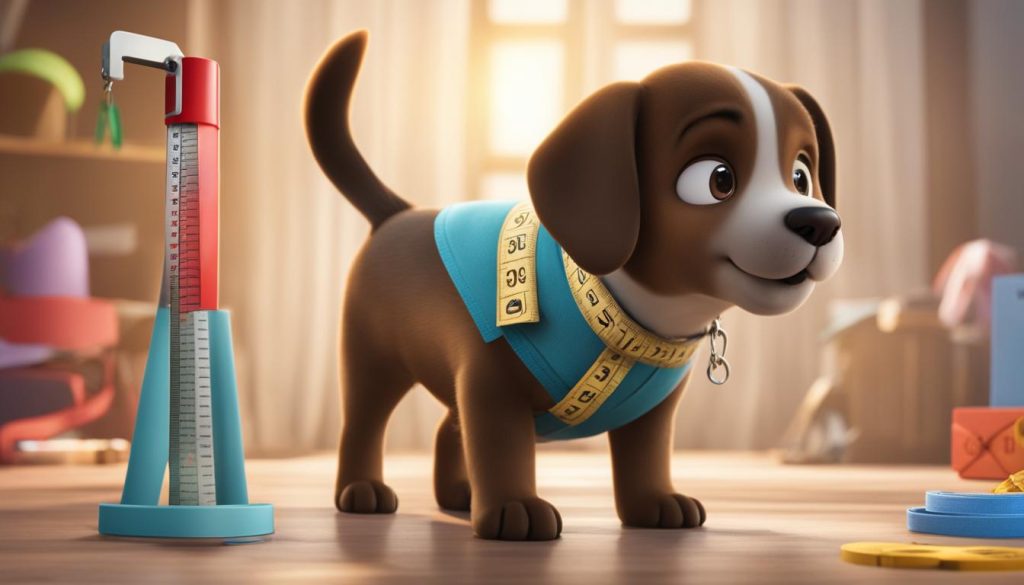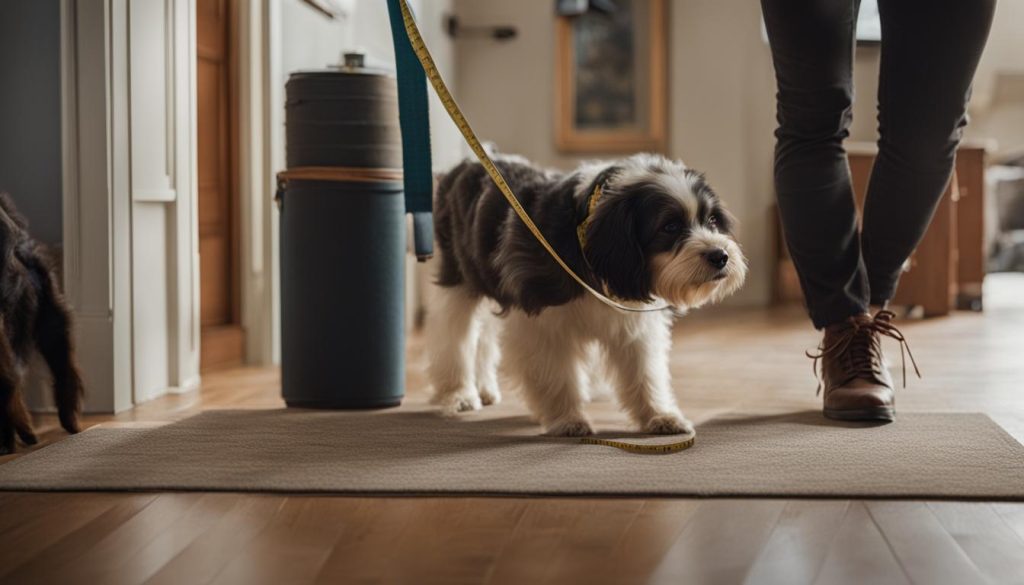When it comes to buying products for your dog, such as harnesses, collars, or coats, knowing your dog’s measurements, including its height, is crucial for ensuring the right fit. However, measuring a dog’s height accurately can be a challenge. In this comprehensive guide, I will provide you with step-by-step instructions and techniques on how to measure your dog’s height accurately. By following these methods, you can ensure that you are getting the correct measurements for your dog’s height, whether it is for show purposes or personal knowledge.
Key Takeaways:
- Accurate measurement of your dog’s height is essential for finding the right size accessories and equipment.
- Measuring your dog’s height helps monitor its growth and overall health.
- There are various methods for measuring dog height, including using a measuring tape and everyday objects.
- Consider factors such as breed standards and your dog’s cooperation during the measurement process.
- Consulting with a veterinarian or professional dog handler can provide expert guidance for specific purposes or competitions.
Why Measuring Your Dog’s Height is Important

Measuring your dog’s height is an essential practice with numerous benefits. By knowing your dog’s height, you can determine if it falls within the standard range for its breed, which is crucial for show purposes. Properly measuring your dog’s height also assists in selecting the right size crate, bed, or other accessories, ensuring optimal comfort and functionality. Moreover, regular height measurements enable you to monitor your dog’s growth and overall health. By detecting any potential size or growth abnormalities early on, you can take necessary actions to address them promptly.
Measuring your dog’s height plays a vital role in understanding its physical development and maintaining its well-being. The information acquired through accurate height measurements empowers dog owners to make informed decisions regarding various aspects of their pet’s life. Whether it’s for show competitions or day-to-day care, measuring your dog’s height is an essential practice that promotes their comfort, health, and happiness.
The Importance of Measuring Dog Height
Regularly measuring your dog’s height ensures that it is developing properly and helps detect any potential size or growth abnormalities.
Measuring your dog’s height accurately is particularly important for breeds that have specific height standards for different purposes, such as show dogs. By adhering to these standards, you can ensure your dog’s eligibility for competitions and maintain the breed’s conformation. Furthermore, measuring height helps you make informed decisions when selecting accessories or equipment for your dog. The right size crate, bed, or harness ensures comfort and safety, preventing any potential discomfort or injuries caused by ill-fitting items.
Additionally, tracking your dog’s height over time allows you to monitor its growth progress. By comparing previous measurements, you can identify any significant deviations in growth patterns, which can indicate underlying health issues that require attention. Regularly measuring your dog’s height and recording the information provides a valuable resource for veterinarians to assess your dog’s overall health, contribute to accurate medical diagnoses, and inform appropriate treatment plans.
Method 1: Using a Measuring Tape

One of the most common and straightforward methods for measuring a dog’s height is by using a measuring tape. Follow these steps to measure your dog’s height accurately with a measuring tape:
- Ensure that your dog is standing on a flat and level surface.
- Position the measuring tape at the base of your dog’s paws.
- Slowly extend the measuring tape upwards, following the contour of your dog’s body.
- Stop extending the tape once you reach the highest point of your dog’s shoulders, also known as the withers.
- Make sure the tape is straight and not twisted.
- Read the measurement where the tape meets the withers. This is your dog’s height.
Remember to take multiple measurements to ensure accuracy, and if possible, have someone assist you to keep your dog still during the process. This method provides a precise measurement of your dog’s height, allowing you to determine the perfect fit for various accessories and ensuring your dog falls within the standard height range for its breed.
Method 2: Using Everyday Objects

If you don’t have a measuring tape handy, you can still estimate your dog’s height using everyday objects found around your house. It’s a simple yet effective way to get a rough measurement. Here’s how you can do it:
- Find a sturdy book or a flat object with a straight edge.
- Place the book or object vertically against a wall.
- Guide your dog to stand next to the wall.
- Ensure that your dog is standing straight and at its tallest posture.
- Align the bottom edge of the book or object with the top of your dog’s shoulders.
- Mark the wall at the highest point reached by the object.
- Remove the object and measure the distance from the floor to the mark using a measuring tape or any other measuring device.
By using everyday objects as a reference, you can get a close approximation of your dog’s height. Keep in mind that this method may not provide as precise a measurement as using a measuring tape, but it can still give you a good idea of your dog’s size.
If you prefer a visual representation, refer to the table below for common household items and their corresponding height measurements:
| Everyday Object | Approximate Height |
|---|---|
| Standard soda can | 4.83 inches (12.3 cm) |
| Average paperback book | 8.5 inches (21.6 cm) |
| Dinner plate | 1 inch (2.54 cm) – size varies |
| Cutting board | 0.75 inches (1.9 cm) – size varies |
| Standard ruler | 12 inches (30.5 cm) |
Remember, these measurements are only estimates and should be used as a rough guide. If you require more accurate measurements, it is recommended to use a measuring tape or consult with a professional.
Now that you have learned about measuring dog height with everyday objects, let’s explore the factors that can affect the accuracy of your measurements in the next section.
Factors to Consider When Measuring Dog Height

Accurately measuring your dog’s height requires careful consideration of several factors that can affect the accuracy of the measurement. By understanding these factors, you can ensure a more reliable and precise measurement for your dog’s height.
1. Breed Variations
Different dog breeds vary significantly in terms of their height. Breed standards and body proportions can affect how you measure and interpret a dog’s height. It is crucial to familiarize yourself with the specific breed standards and guidelines to ensure accurate measurements.
2. Age and Growth Stage
The age and growth stage of your dog can impact its height measurement. Puppies are still growing and may not have reached their full adult height. It’s essential to consider the age and development stage of your dog when measuring its height, as measuring a puppy’s height will be different from measuring an adult dog’s height.
3. Posture and Measurement Technique
The posture and measurement technique can influence the accuracy of dog height measurements. Ensure that your dog is standing upright on all four legs, with its head held naturally, to get the most accurate height measurement. Additionally, consistency in how you measure your dog’s height each time will yield more reliable results.
4. Observer Bias
Observer bias can also impact dog height measurements. Different individuals may measure the same dog differently due to variations in technique, posture, or interpretation. To minimize observer bias, it is recommended to have a consistent person perform the measurements or seek professional guidance if precise measurements are needed.
5. Equipment and Measurement Tools
The type and quality of the measurement tools used can affect the accuracy of dog height measurements. Ensure that the measuring tape or other tools are calibrated correctly and free from stretching or distortion. Using reliable and appropriate equipment will contribute to more precise measurements.
6. Environmental Factors
Environmental factors can also impact the accuracy of dog height measurements. Factors such as uneven ground, slippery surfaces, or distractions can affect the posture and stability of the dog during the measurement process. Ensure that you choose a suitable location and minimize any potential disruptions for more accurate measurements.
7. Health and Physical Condition
A dog’s health and physical condition can impact its posture and overall height. Dogs with health issues or musculoskeletal conditions may have deviations in their posture, affecting the measurement results. It’s important to consider your dog’s health and consult with a veterinarian if you suspect any underlying conditions that may impact the accuracy of the height measurement.
Incorporating these factors into your dog height measurement process will help ensure more accurate and reliable results. By considering the breed variations, age, posture, measurement technique, observer bias, equipment, environment, and health factors, you can obtain the most precise measurement of your dog’s height.
Factors Affecting Dog Height Measurement
| Factors | Description |
|---|---|
| Breed Variations | Different dog breeds have varying height standards and body proportions, which affect how you measure and interpret height. |
| Age and Growth Stage | Puppies are still growing and may not have reached their full adult height, requiring consideration of their age and developmental stage. |
| Posture and Measurement Technique | The posture and technique used during measurement can impact accuracy. Ensure the dog stands upright and consistently measure in the same way. |
| Observer Bias | Different individuals may measure the same dog differently due to variations in technique, posture, or interpretation. |
| Equipment and Measurement Tools | The type and quality of measurement tools used can affect accuracy. Ensure reliable and properly calibrated tools are utilized. |
| Environmental Factors | Environmental conditions, such as uneven surfaces or distractions, can impact posture and stability during measurement. |
| Health and Physical Condition | A dog’s health and physical condition, including musculoskeletal issues, can affect posture and height measurements. |
Tips for Measuring an Uncooperative Dog

Not all dogs are cooperative when it comes to being measured. If your dog is uncooperative or fidgety during the measurement process, here are some tips to help you get accurate measurements:
-
Choose a calm and familiar environment: Find a quiet and familiar space where your dog feels comfortable. This can help reduce anxiety and make the measuring process easier.
-
Use treats or rewards: Use treats or rewards as positive reinforcement to encourage your dog to stay still. Rewarding good behavior with treats can help keep your dog focused and cooperative.
-
Have an assistant: Enlist the help of a second person to hold your dog or distract them with toys or treats. This can help keep your dog occupied and minimize movement during the measurement.
-
Divide the measurement process: If your dog is particularly uncooperative, try dividing the measurement process into smaller steps. Measure one part of your dog’s height at a time, such as the shoulder height or back height. This can make it easier to get accurate measurements without overwhelming your dog.
-
Be patient and gentle: Approach the measuring process with patience and a gentle touch. Speak softly to your dog and avoid sudden movements that may startle them. Creating a calm and soothing environment can help your dog feel more relaxed.
By following these tips, you can increase the chances of measuring your uncooperative dog accurately. Remember, it’s important to prioritize your dog’s comfort and well-being throughout the measurement process.
Recording and Tracking Your Dog’s Height
![]()
Keeping a record of your dog’s height is vital for effectively monitoring its growth and overall health. By consistently tracking your dog’s height, you can identify any growth abnormalities or issues early on. Here are some methods you can use to record and track your dog’s height:
1. Measuring Chart
Create a measuring chart specifically for your dog’s height. Use a large poster board or a dedicated notebook where you can track your dog’s height over time. Start by recording your dog’s initial height measurement and date, and then continue to update the chart with subsequent measurements over the weeks, months, and years. This method allows you to visually observe your dog’s growth progression.
2. Digital Records
Create a digital record of your dog’s height using a spreadsheet or a note-taking app on your smartphone or computer. This method allows for easy updating and tracking of your dog’s height measurements. You can also set reminders to measure your dog’s height at regular intervals to ensure accurate and consistent tracking.
3. Photography
Document your dog’s height through photographs. Take pictures of your dog standing against a wall or next to an object of known height at regular intervals. This visual reference will provide a clear indication of your dog’s growth over time. Include the date on each photograph so that you can track the progression accurately.
Remember to measure your dog’s height consistently and record the measurements promptly to ensure accurate tracking. Regularly reviewing and analyzing your dog’s growth patterns can help you identify any potential health concerns and adjust their diet or exercise routine as necessary.
Understanding Different Height Measurements for Dogs
When it comes to measuring a dog’s height, there are different measurements to consider. Understanding these different height measurements is essential for accurately assessing your dog’s size and determining if it falls within the standard height range for its breed. Additionally, it allows you to compare the real height of your dog with the ideal height, which can be useful for various purposes. Let’s explore these different height measurements:
Standard Height Measurement for Dogs
The standard height measurement for dogs is typically defined by breed standards set by kennel clubs and breed organizations. These standards specify the range of acceptable heights for each breed, ensuring uniformity and consistency in show competitions and breed evaluations.
Real Height vs. Ideal Height
There is often a distinction between a dog’s real height and its ideal height. The real height refers to the actual measurement of a dog’s height, taken accurately using the appropriate techniques. On the other hand, the ideal height is the desired height specified in breed standards. The ideal height serves as a benchmark for evaluating a dog’s conformation and adherence to breed characteristics.
Different Height Measurements for Dogs
Aside from the standard height measurement and the comparison between real height and ideal height, there are other height measurements that can provide valuable insights into a dog’s size and proportions. These include:
- Withers Height: The measurement from the highest point of a dog’s shoulder blades, known as the withers, to the ground. It is commonly used to determine a dog’s height.
- Shoulder Height: Similar to withers height, this measurement refers to the distance from the top of a dog’s shoulder to the ground. It is often used as an alternative method for measuring a dog’s height.
- Cross Height: This measurement is taken from the highest point of a dog’s back, just behind the shoulder blades, to the ground. It provides an additional reference point for determining a dog’s height.
- Chest Height: The chest height is the distance from the ground to the deepest part of a dog’s chest. While not a direct measurement of a dog’s height, it can be helpful in assessing overall proportions and size.
By considering these different height measurements, you can gain a comprehensive understanding of your dog’s size and ensure that it aligns with breed standards and expectations.
Determining the Correct Size for Accessories and Equipment
Choosing the right size for your dog’s accessories and equipment is crucial to ensure a comfortable and secure fit. The size of various items such as harnesses, collars, coats, and crates depends on your dog’s measurements, including its height. By accurately measuring your dog’s height, you can make informed decisions when selecting the appropriate size for these items.
Accessories
When it comes to accessories like harnesses and collars, choosing the right size is essential for both comfort and effectiveness. A properly fitting harness or collar should allow your dog to move freely without causing any discomfort or restrictions. To determine the correct size for these accessories, take your dog’s height measurement and refer to the manufacturer’s size chart, which will usually provide guidance on correlating height to size.
For example, if your dog’s height falls between a small and medium size range, you can use the size chart to determine which size would be the best fit. Remember that sizes may vary between brands, so it’s important to consult each manufacturer’s specific size chart for accurate measurements.
Equipment
When it comes to equipment such as crates, beds, and strollers, choosing the right size is crucial for your dog’s comfort and safety. A crate or bed that is too small can make your dog feel cramped and uncomfortable, while one that is too large may not provide the cozy and secure feeling they need. By using your dog’s height measurement, you can select the appropriate size of equipment that suits their needs.
For example, when choosing a crate, consider the height and length measurements to ensure your dog has enough space to stand, turn around, and lie down comfortably. Similarly, when selecting a bed or stroller, refer to the manufacturer’s size recommendations that correlate with your dog’s height measurement.
Remember that the correct size for accessories and equipment may also depend on other factors such as your dog’s weight and breed. It’s always a good idea to consult the manufacturer’s recommendations and consider your dog’s individual needs when making these choices.
By accurately determining the correct size for your dog’s accessories and equipment, you can ensure a comfortable and safe experience for your canine companion. Make sure to measure your dog’s height accurately and refer to the manufacturer’s size charts and recommendations for the best fit. Your dog will thank you for the extra attention to detail and the perfectly tailored accessories and equipment!
Seeking Professional Guidance
If you are unsure about how to accurately measure your dog’s height or if you require more precise measurements for specific purposes, such as show competitions or professional needs, it is highly recommended to consult with a veterinarian or professional dog handler. These experts have the necessary knowledge, expertise, and tools to provide professional dog measurements and tailored guidance for your unique situation.
Consulting with a veterinarian or professional dog handler ensures that you receive accurate and reliable measurements for your dog’s height. They are familiar with breed standards and can accurately assess your dog’s height according to specific guidelines, whether it is for show purposes or any other professional requirements.
Having professional dog measurements is particularly crucial if you are participating in show competitions where precise measurements are essential for eligibility. A veterinarian or professional dog handler can measure your dog’s height following the specific rules and guidelines set by the competition organizers.
Moreover, seeking expert advice for dog measurements is valuable when you need to determine the correct size for specialized accessories or equipment. If you are looking for a custom-fitted harness, vest, or any other professional dog gear, consulting with a professional ensures that you select the appropriate size and fit to cater to your dog’s specific needs and measurements.
Remember, professional guidance from a veterinarian or professional dog handler significantly enhances the accuracy of your dog’s height measurements and ensures that you make informed decisions when it comes to your dog’s accessories, competitions, or other professional endeavors.
When it comes to your furry companion, accuracy matters, and seeking professional advice is key to obtaining reliable insights into your dog’s measurements.
Regularly Monitoring Your Dog’s Height
Regularly monitoring your dog’s height is essential, especially during its growth stages. By measuring your dog’s height periodically, you can track its growth progress and ensure that it is developing properly. This is particularly important for puppies, as they go through significant growth spurts and changes in body proportions.
Tracking your dog’s height changes allows you to keep a close eye on their growth rate and identify any potential issues or abnormalities early on. If you notice any significant deviations or concerns, it is recommended to consult with your veterinarian for further evaluation and guidance.
H3>Benefits of Regularly Monitoring Your Dog’s Height
- Allows you to ensure your dog is growing at a healthy rate
- Helps detect any growth abnormalities or potential health issues
- Enables you to make informed decisions regarding your dog’s diet and exercise
- Aids in selecting the appropriate size of accessories and equipment
Regular measurement of your dog’s height provides valuable data for their overall health and well-being. It allows you to make informed decisions about their nutrition, exercise, and overall care. By monitoring your dog’s growth, you can detect any potential issues early on and take appropriate steps to address them.
Remember, every dog is unique, and their growth and development may vary. If you have any concerns about your dog’s height or growth, it is always best to consult with your veterinarian, who can provide personalized advice and guidance based on your dog’s breed, age, and health history.
Wrapping Up
Accurately measuring your dog’s height is crucial for a variety of reasons. By following the methods and tips outlined in this comprehensive guide, you can ensure precise and reliable measurements. This will enable you to choose the right size accessories, monitor your dog’s growth, and participate in show competitions confidently. Remember to record and track your dog’s height measurements regularly to keep a check on its overall health and development.
Measuring your dog’s height accurately is the key to finding the perfect fit for accessories such as harnesses, collars, and coats. It also helps in determining if your dog falls within the standard height range for its breed, which is important for show purposes. By measuring your dog’s height, you can assess its growth progress and spot any potential issues related to size or growth abnormalities. Taking accurate measurements will save you time and money, as you can confidently choose the right size crate, bed, or other equipment for your dog.
Whether you are a pet owner or a professional handler, the guide provided here offers comprehensive techniques to measure your dog’s height accurately. By understanding the importance of accurate dog height measurement, you can ensure that your furry friend receives the best care and is provided with accessories and equipment that fit perfectly. So, grab your measuring tape and start measuring your dog’s height today!
FAQ
Why is measuring my dog’s height important?
Measuring your dog’s height is important for various reasons, including determining if your dog falls within the standard height range for its breed, choosing the right size accessories, monitoring your dog’s growth and overall health, and participating in show competitions.
How can I measure my dog’s height using a measuring tape?
To measure your dog’s height using a measuring tape, follow these steps: 1) Stand your dog on a level surface with its four paws together, 2) Place the measuring tape at the ground next to your dog’s paws, 3) Extend the tape measure vertically up to your dog’s withers, or the highest point of its shoulder blades, 4) Read and record the measurement in inches or centimeters.
Can I use everyday objects to estimate my dog’s height?
Yes, if you don’t have a measuring tape, you can use everyday objects to estimate your dog’s height. For example, you can use a ruler, a yardstick, a book, or even a stack of paper. Place the object next to your dog and make a mark at its shoulder height. Then measure the height from the ground to the mark.
What factors should I consider when measuring my dog’s height?
When measuring your dog’s height, it’s important to consider factors such as age, breed standards, physical condition, and posture. These factors can affect the accuracy of the measurement, so make sure to take them into account when measuring your dog’s height.
What should I do if my dog is uncooperative during the measurement process?
If your dog is uncooperative or fidgety during the measurement process, here are some tips to help you get accurate measurements: 1) Use treats or toys to keep your dog focused and still, 2) Have someone assist you in holding or distracting your dog while you measure, 3) Take multiple measurements and average them to get a more accurate result.
How can I record and track my dog’s height?
To record and track your dog’s height, you can create a dedicated growth chart or use a spreadsheet or journal to keep a record of each measurement along with the date. This will help you monitor your dog’s growth progress and detect any significant deviations or concerns.
What are the different height measurements for dogs?
When measuring a dog’s height, different measurements to consider include the real height, which is the actual measurement from the ground to the withers, and the ideal height, which is the height specified in the breed standard for show purposes.
How can measuring my dog’s height help in determining the correct size for accessories?
Measuring your dog’s height accurately is crucial for choosing the right size for various dog accessories such as harnesses, collars, coats, crates, and beds. By knowing your dog’s height, you can ensure a proper fit and provide your dog with comfort and safety.
Should I consult with a professional for accurate dog height measurements?
If you are unsure or need more accurate measurements for specific purposes, such as show competitions or professional purposes, it is recommended to consult with a veterinarian or professional dog handler. They have the expertise and tools to provide precise measurements and guidance tailored to your dog’s individual needs.
Why is it important to regularly monitor my dog’s height?
Regularly measuring your dog’s height is essential, especially during its growth stages. By monitoring your dog’s height, you can track its growth progress, ensure that it is developing properly, and detect any potential issues related to size or growth abnormalities.






